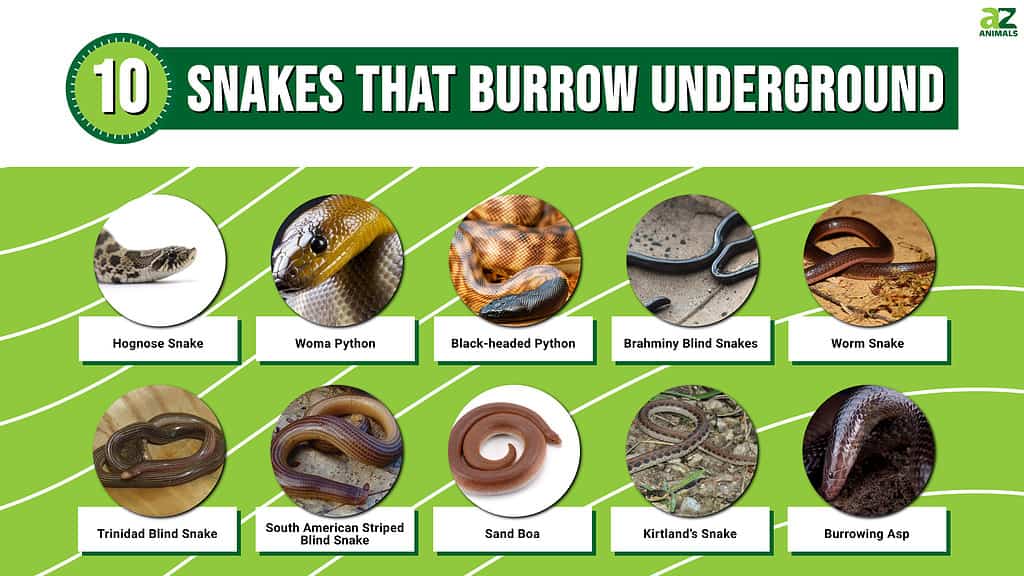
Most snakes coopt holes that other animals have dug, but some actually burrow underground themselves. Fossorial (burrowing) snakes are good at digging. They burrow to stay safe from predators, stay warm, or even lie in wait for prey. Some studies indicate that fossorial snakes go extinct at a greater rate than non-fossorial snakes.
10. Burrowing Asp
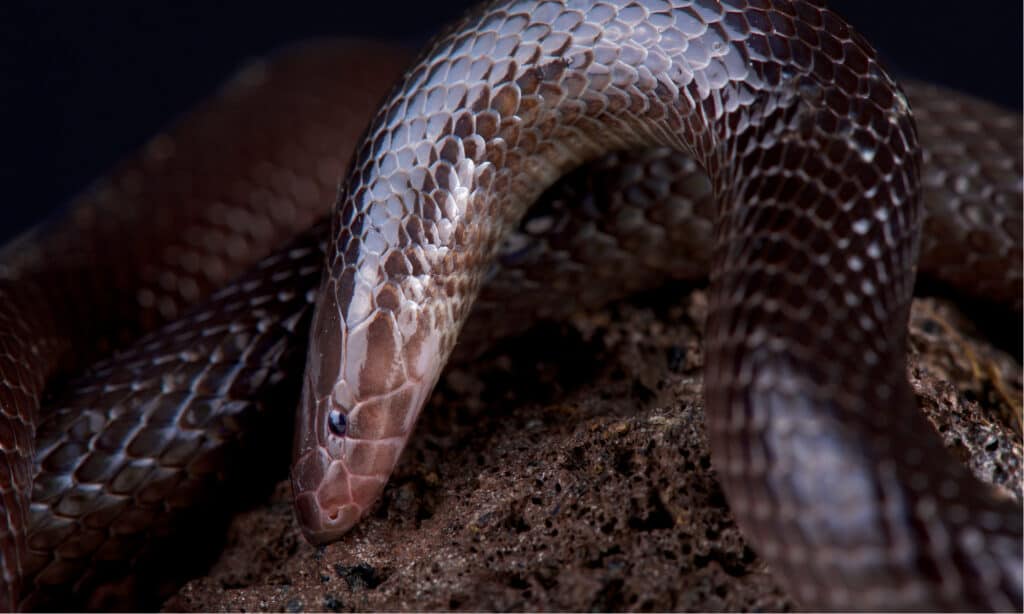
Generally dark and thick-bodied, burrowing asps range from 1-4 feet in length and spend their entire lives on, or in, the ground.
©reptiles4all/Shutterstock.com
There is actually an entire genus of snakes known as ‘burrowing asps.’ These snakes live in northern Africa and the Middle East, where they’re often highly feared because of their venom. There are at least 15 species of burrowing asp, though many experts argue that there are more.
Burrowing asps are all venomous, and they have the ability to ‘side stab,’ by poking their fangs out the sides of their mouths. Most species are dark brown to black, with small heads. As snakes that burrow underground, most of their diet comes from ground-dwelling small mammals and reptiles.
9. Kirtland’s Snake
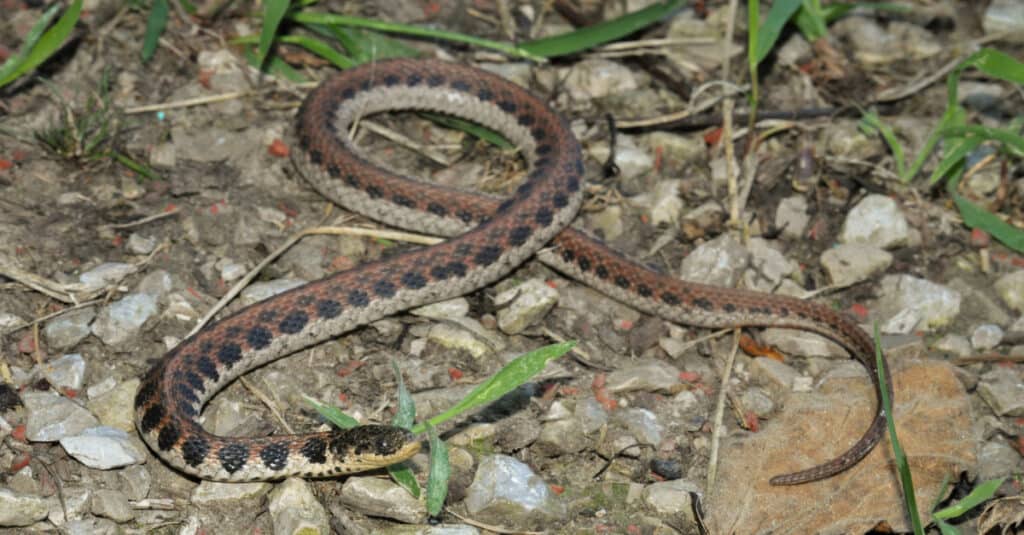
Found predominantly in the midwestern United States, Kirtland’s snakes are small and secretive.
©Mike Wilhelm/Shutterstock.com
One of the United States’ snakes that burrow underground, the Kirtland’s snake makes rare appearances. Kirtland’s snakes grow to a maximum length of two feet and spend most of their time hiding in loose soil or under leaf litter. They have orange-red undersides and tan bodies covered in dark, circular markings. Kirtland’s snakes are exceptionally rare and live mostly in wetlands, prairies, and marshes.
8. Sand Boa

Though closely related to the famous boa constrictors, sand boas have a very different appearance.
©iStock.com/PetlinDmitry
One subfamily of snakes that burrow underground comprises species of snakes known as sand boas. Sand boas are related to other boa snakes (like boa constrictors) yet distinct enough from them to merit their own grouping. There are around 15 species of sand boa living in North America, Southeast Asia, Africa, and Europe.
Like all burrowing snakes, sand boas have heads no wider than their necks. They grow to about four feet long for the largest species and have small eyes. As their name suggests, they burrow in the sand, coming out only to ambush prey. Like all boas, sand boas are non-venomous constrictors.
7. South American Striped Blind Snake

Out of all the snakes on our list, the South American striped blind snake has one of the thickest bodies and smallest heads.
©Sampaio ILR, Photograph credits: Ivan L. Sampaio (A, B, D, E, H, I), Frederico G. França (F, G, J, L), Pedro T. S. Moura (C) Rafaela C. França (K). Santos CP, França RC, Pedrosa IMMC, Solé M, França FGR (2018) Ecological diversity of a snake assemblage from the Atlantic Forest at the south coast of Paraíba, northeast Brazil. ZooKeys 787: 107-125. https://doi.org/10.3897/zookeys.787.26946 / Creative Commons – License
These snakes that burrow underground are also known as Brongersma’s worm snakes. They’re completely blind and live in Central and South America. Striped blind snakes range in color from light brown to dark brown and grow up to one foot long. Unlike other larger snakes, striped blind snakes eat only insects, mostly termites and ants. They spend most of their lives underground, where they don’t need eyes to see.
6. Trinidad Blind Snake
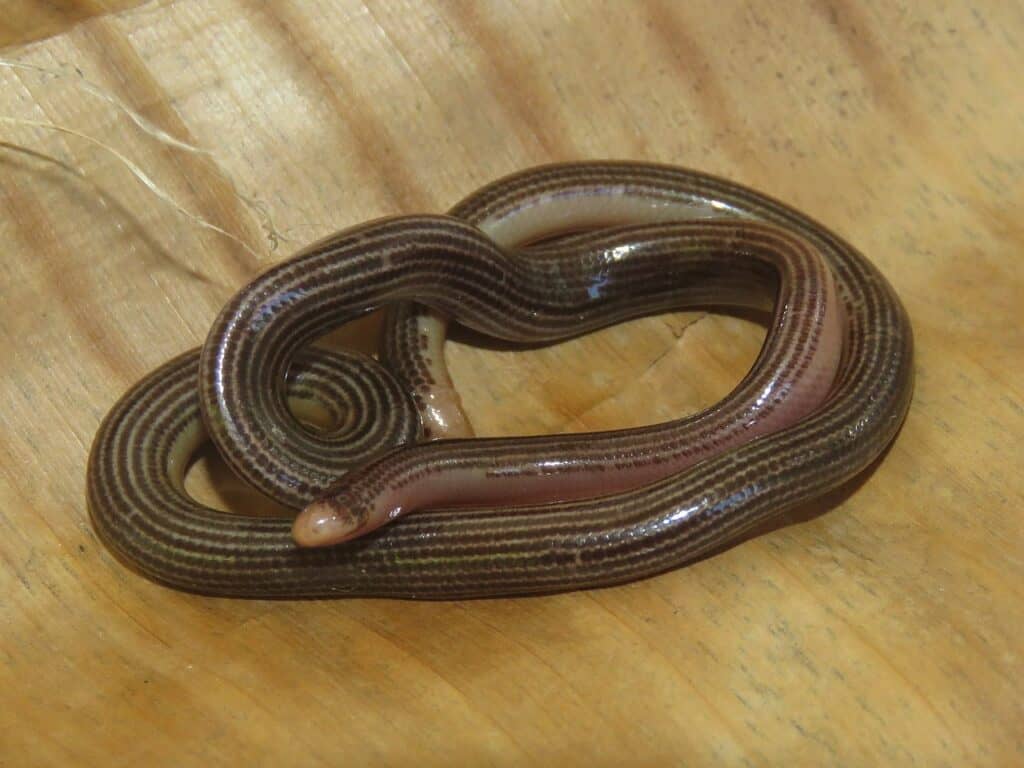
Currently listed as endangered, the Trinidad blind snake lives in only a few places on Earth.
©Mike G. Rutherford / Creative Commons – License
Closely related to South American striped blind snakes, Trinidad blind snakes also lack vision. Their eyes are extremely small and useless, and their heads are not differentiated from their necks in any way. Trinidad blind snakes are dark brown with pale pink heads, growing up to two feet long. Like South American striped blind snakes, these snakes that burrow underground live in South and Central America.
5. Worm Snake
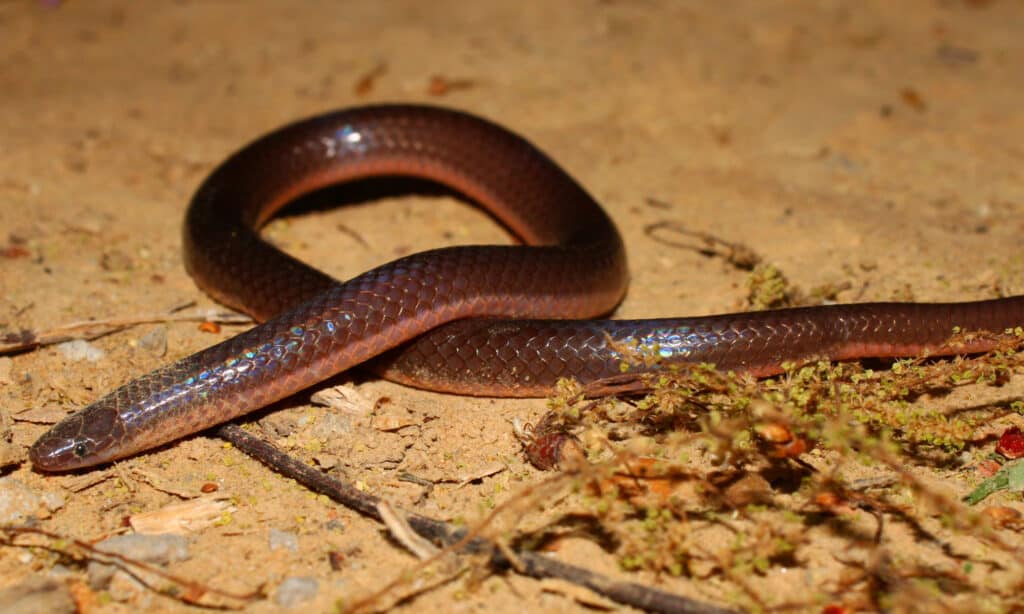
Despite their name, worm snakes are recognizably serpentine, though they are extremely small.
©Jason Patrick Ross/Shutterstock.com
In the eastern parts of North America, there lives a tiny, light brown snake. To find this snake, you would have to go poking around in fallen, rotting trees, under leaf litter, and around loose soil. This snake that burrows underground is so small that it’s actually known as the worm snake. Worm snakes have tiny eyes, narrow heads, and slender bodies that grow to no more than one foot in length. They rarely come out into the open, choosing instead to spend most of their time feasting on tiny insects.
4. Brahminy Blind Snakes

Also known as flowerpot snakes,
Brahminy blind snakes
look like thin, black noodles.
©Patrick K. Campbell/Shutterstock.com
Though originally from Southeast Asia, these snakes that burrow underground have also taken up residence in the southeastern United States, particularly in Florida, where the heat and humidity agree with them. There’s no need to worry, though; Brahminy blind snakes couldn’t hurt a human if they tried.
One of the most harmless snakes on the planet, Brahminy blind snakes spend their lives hunting underground for ant eggs and pupae. They grow to around one foot long and rarely appear above ground.
3. Black-headed Python
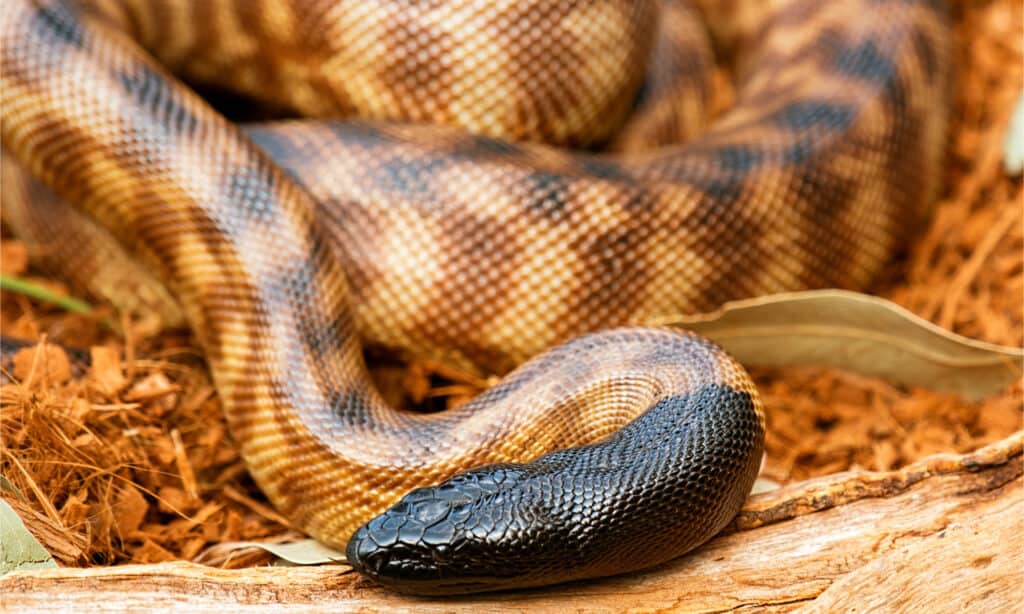
A popular pet species, the black-headed python draws herpetological enthusiasts with its distinct coloring.
©Rob D the Baker/Shutterstock.com
As their name suggests, black-headed pythons have all black heads with tan bodies. They generally grow to around six feet long, though some have grown even longer. These snakes that burrow are native to the northern parts of Australia, where they spend their time in loose soil and rocks. Black-headed pythons may not be venomous, but they eat their fair share of snakes and other reptiles.
2. Woma Python
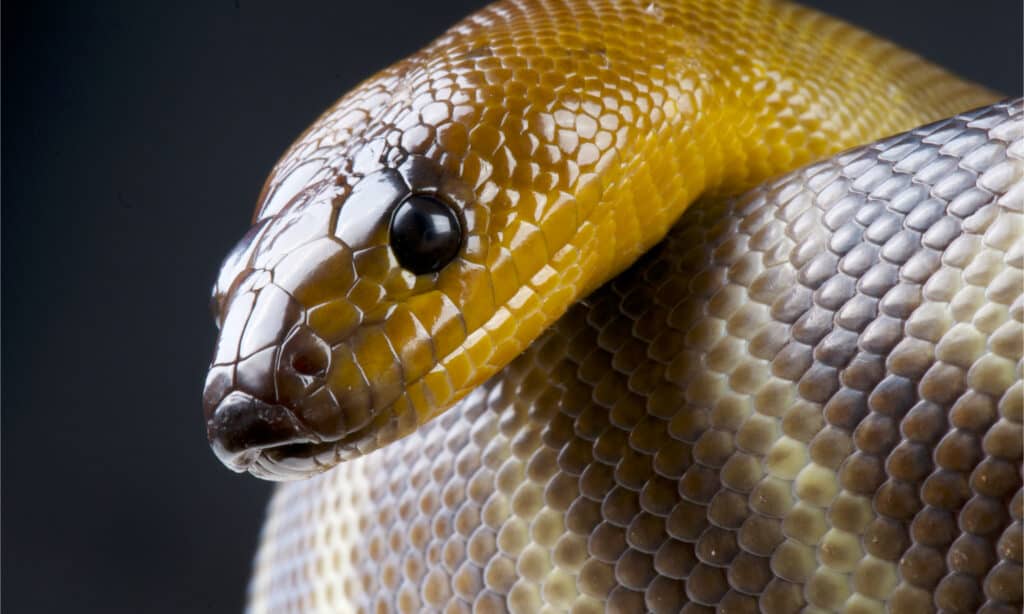
One of the most peculiar pythons, the Woma python is also known as the sand python or Ramsay’s python.
©reptiles4all/Shutterstock.com
Like all snakes that burrow underground, Woma pythons have small heads with tiny eyes. They grow to around five feet long, with tan-colored bodies and faint stripes. Woma pythons are native to Australia, where they stick to rotting logs and leaf litter for cover. They eat mainly reptiles but will also eat small mammals if given the chance.
1. Hognose Snake
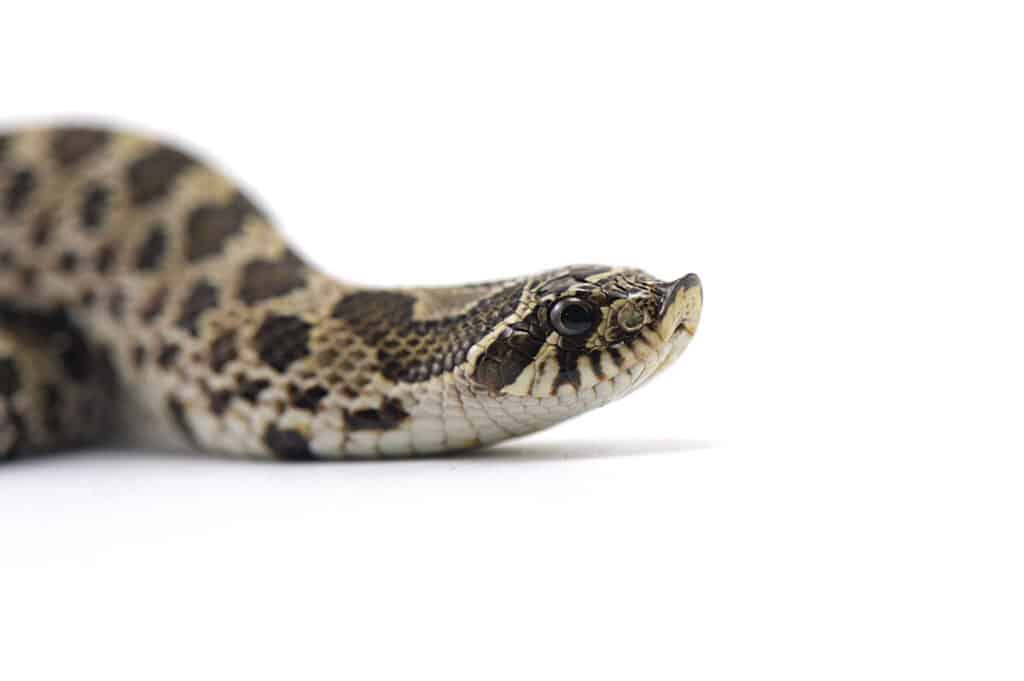
There are several species in the genus Heterodon, commonly known as hognose snakes.
©PetlinDmitry/Shutterstock.com
Number one on our list of snakes that burrow underground is the hognose snake, also known as the hog-nosed snake. While the name ‘hognose’ does not refer to one individual species, each species in this genus shares a few common characteristics. These include, most importantly, an upturned, pig-like nose that comes in handy for digging through loose dirt and leafy detritus. Hognose snakes are small, with most measuring under two feet long, and harmless to humans.
Other Reptiles That Burrow Underground
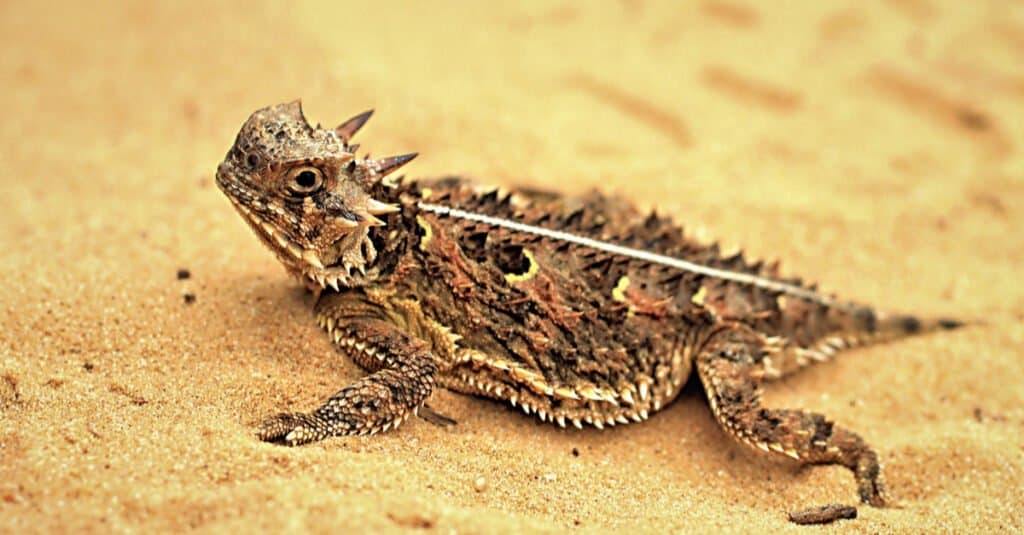
Horned lizards are known to bury themselves in the sand.
©Seth LaGrange/Shutterstock.com
There are several species of reptiles that burrow into the ground to make their homes. Some of these animals, like skinks and geckos, use shallow tunnels in sand or soil for shelter from predators. The alligator snapping turtle is a large aquatic reptile that will dig deep into the mud at the bottom of streams and ponds to hide away during periods when they may be vulnerable.
The Desert Horned Lizard is an interesting burrowing reptile found mainly in desert regions throughout North America. They are adept at digging burrows with their claws and can fit inside surprisingly small crevices in order to stay out of sight. These lizards also rely on their cryptic coloration to help them blend into their environment while they wait for prey items like insects, spiders, and other small invertebrates nearby.
Another type of reptile known for its underground behavior is the Gopher Tortoise which lives predominantly along coastal areas within southeastern parts of both North America and also Central America. These tortoises dig complex tunnel networks up to ten feet long as well as two feet below ground level in order to escape intense temperatures aboveground, as well as potential predators such as foxes or coyotes who might want a free meal! Their burrows can often provide homes for many other creatures, including garter snakes or frogs since it provides a safe space from extreme weather conditions or predation risks outside their walls!
Summary of 10 Snakes That Burrow Underground
| Rank | Snake |
|---|---|
| 1 | Hognose Snake |
| 2 | Woma Python |
| 3 | Black-headed Python |
| 4 | Brahminy Blind Snakes |
| 5 | Worm Snake |
| 6 | Trinidad Blind Snake |
| 7 | South American Striped Blind Snake |
| 8 | Sand Boa |
| 9 | Kirtland’s Snake |
| 10 | Burrowing Asp |
What Snakes Steal Other Animals’ Burrows?

Gopher snakes eared their name for setting up residence in gopher burrows.
©Tim Pleasant/Shutterstock.com
There are a few snakes that didn’t make our top 10 as borrowers. However, they have been known to steal burrows from others…in a rather grotesque way!
One of the main staples in the diet of countless snake species is rodents. Many rodents are burrowers such as mice, rats, ground squirrels, chipmunks, prairie dogs, voles, or gophers. There are also multiple snakes that will steal these animals’ burrows, once they make a meal of the former owner (or find the burrow already vacated). In fact, gopher snakes earned their moniker for setting up shop in gopher holes. However, their main diet consists of rabbits, squirrels, and rats, and they will even climb trees in search of baby birds and bird eggs.
A couple of other snakes that move into burrows dug by rodents include milksnakes and black racers. Some semiaquatic snakes like water snakes and crayfish snakes will take the burrows of frogs and crayfish. And indigo snakes have been known to inhabit burrows created by gopher tortoises.
The photo featured at the top of this post is © RealityImages/Shutterstock.com
Discover the "Monster" Snake 5X Bigger than an Anaconda
Every day A-Z Animals sends out some of the most incredible facts in the world from our free newsletter. Want to discover the 10 most beautiful snakes in the world, a "snake island" where you're never more than 3 feet from danger, or a "monster" snake 5X larger than an anaconda? Then sign up right now and you'll start receiving our daily newsletter absolutely free.
Thank you for reading! Have some feedback for us? Contact the AZ Animals editorial team.







